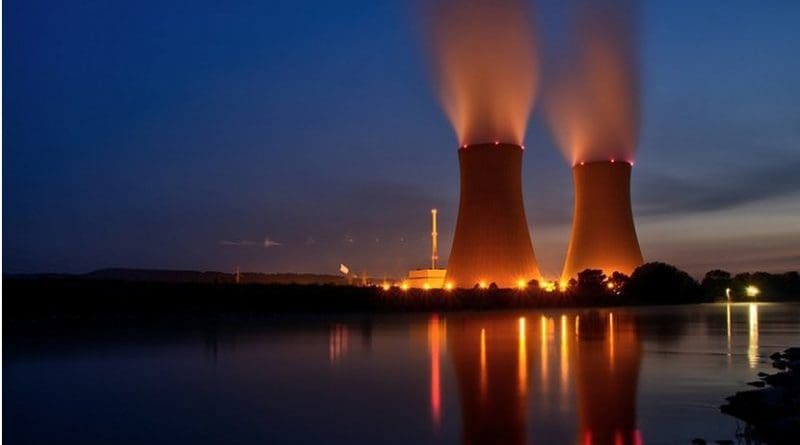Nuclear Power Makes A Comeback In Europe – OpEd
By Arab News
By Zaid M. Belbagi*
When electricity was generated by a nuclear reactor for the first time in 1951, this miracle fuel provided an opportunity for war-torn European countries to rebuild. Following the 1973 oil crisis, the demand for power became so great that a rapid expansion in nuclear generation took place, with France constructing 25 nuclear power plants in 15 years.
However, with time and following several major incidents, power generation from nuclear fission, nuclear decay and nuclear fusion became more controversial. Many major nuclear powers presented timetables for the winding down of their reactors as a result. That was, of course, until Russia’s invasion of Ukraine in February. Amid high energy prices and uncertainty around Russian gas supplies to Europe, the unmistakable yellow and black radiation warning signs look set to remain as the continent turns once more to its nuclear power stations.
The two offshore natural gas pipelines that run under the Baltic Sea from Russia to Germany, known as Nord Stream, are central to the continent’s energy security. The two longest undersea pipelines in the world, with a capacity of more than 100 billion cubic meters of gas per year, were fiercely opposed owing to concerns that they would increase Russia’s influence in Europe. Given that the majority stakeholder is Russian state company Gazprom, this critical infrastructure has always been, despite assurances, a potential Russian chokehold over Europe.
It was therefore unsurprising that, owing to Western opposition to Moscow’s military action in Ukraine, Nord Stream 1 was temporarily shut down for reasons of maintenance and most recently halted altogether owing to a lack of equipment, supposedly because of the Western sanctions on Russia. Amid the disorder, Gazprom issued a statement confirming Europe’s greatest fears, namely declaring force majeure in that it cannot fulfill its supply obligations because of “extraordinary circumstances.” Though, legally speaking, the declaration was intended to release Gazprom from its contractual obligations, it was in reality tantamount to Russia’s weaponization of energy supplies.
So, Europe is turning once again toward nuclear power. Much as the petroleum crisis of the 1970s focused minds in Japan and France, the next few winters are likely to be difficult for governments and for vulnerable households to manage.
Not only did Russia supply 45 percent of the EU’s total gas imports last year, but it has also consistently sought to create uncertainty around Nord Stream. In August 2021, prior to the invasion of Ukraine, it began reducing supplies to the EU in an attempt to drive up prices and reopen the case for investment in Nord Stream 2. After the start of the war, supplies were further reduced when it was demanded that European companies pay in rubles, causing deliveries to 12 member states to be partly or completely stopped.
With winter on the horizon, Europe needs to diversify not only its suppliers, but also its energy sources.
The immediate solution is to extend reliance on coal-powered plants or nuclear reactors. Though both are unpopular with campaigners, so acute is the current global economic situation that European governments have little option.
France’s energy minister this month said that power giant EDF had committed to restarting all of its nuclear reactors by this winter to help consumers. In Germany, the crisis has caused a rupture in Olaf Scholz’s new administration, as Europe’s largest economy struggles to keep going through the winter. His economy minister announced that electricity blackouts “cannot be fully ruled out” and, despite being a leading figure within The Greens party, committed to keeping two of Germany’s three final nuclear power plants on standby, taking them way beyond the closure deadline previously set.
In such circumstances, it is likely that the German government will commit to a longer-term extension of the life of the country’s nuclear power plants. In circumstances where, in Germany and across Europe, mothballed coal-fired power plants are being used to generate electricity, a choice between this — the most environmentally damaging source of fuel — and nuclear energy is clear.
Despite the crisis, it would seem that large-scale investment in the power sectors of the past is challenging, as countries strive to reach net-zero emissions by 2050. Though the shortcomings of an overreliance on Russian gas have been exposed, only a committed effort to generate power from renewable sources will offer a long-term solution. However, fully replacing gas and nuclear energy with renewables will take years and such sources are themselves greatly impacted by climate change. The severe drought this summer, believed to be the worst in 500 years, led to a drop in hydropower generation across Europe, while repeated heat waves forced the closure of nuclear reactors over environmental concerns.
For the next two decades, Europe will remain exposed to global energy shocks until sustainable ways of generating renewable power, alongside a change in consumption, can be guaranteed.
• Zaid M. Belbagi is a political commentator and an adviser to private clients between London and the GCC. Twitter: @Moulay_Zaid


Ha ha – misleading headline. The truth is in the last 2 paragraphs.